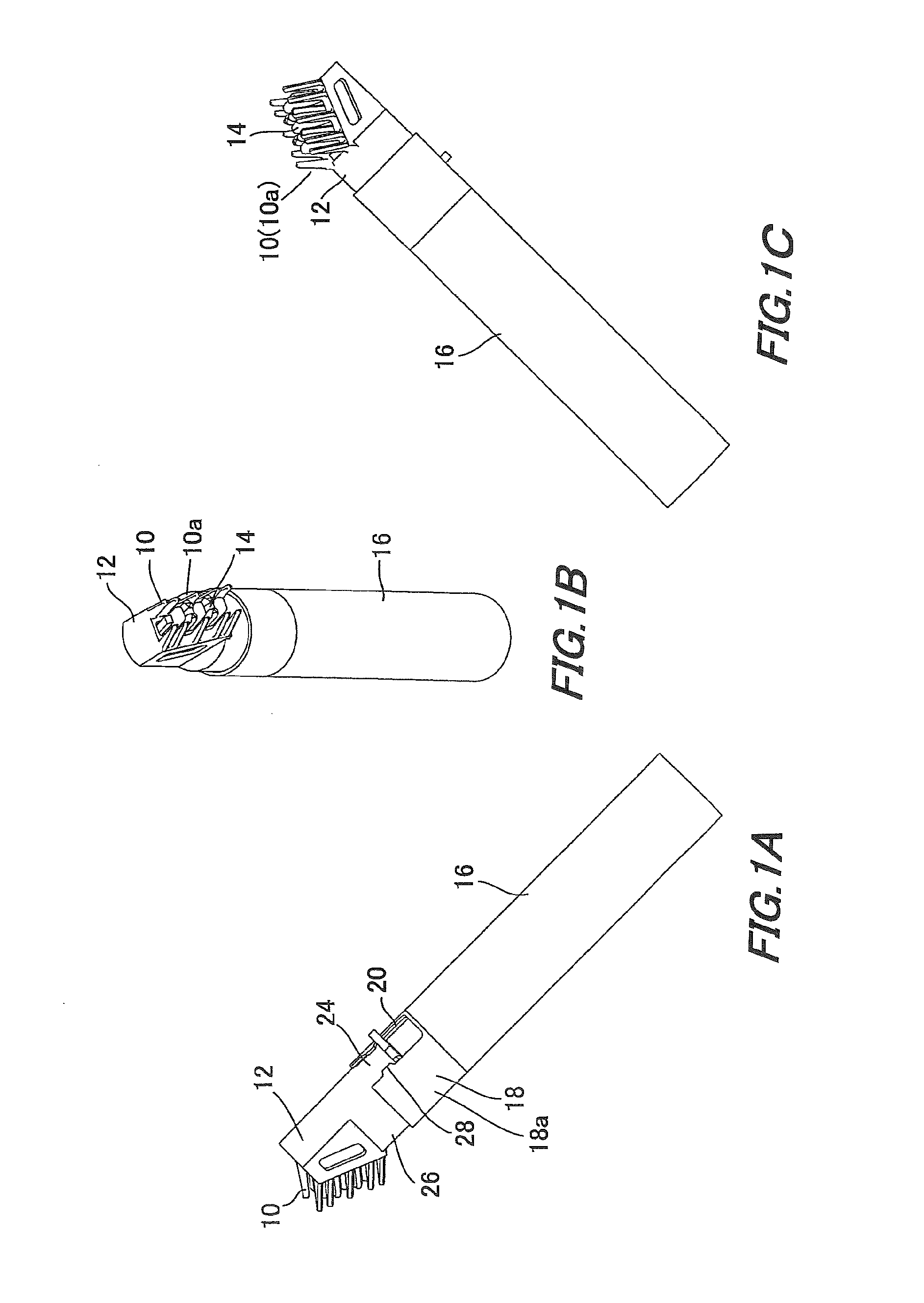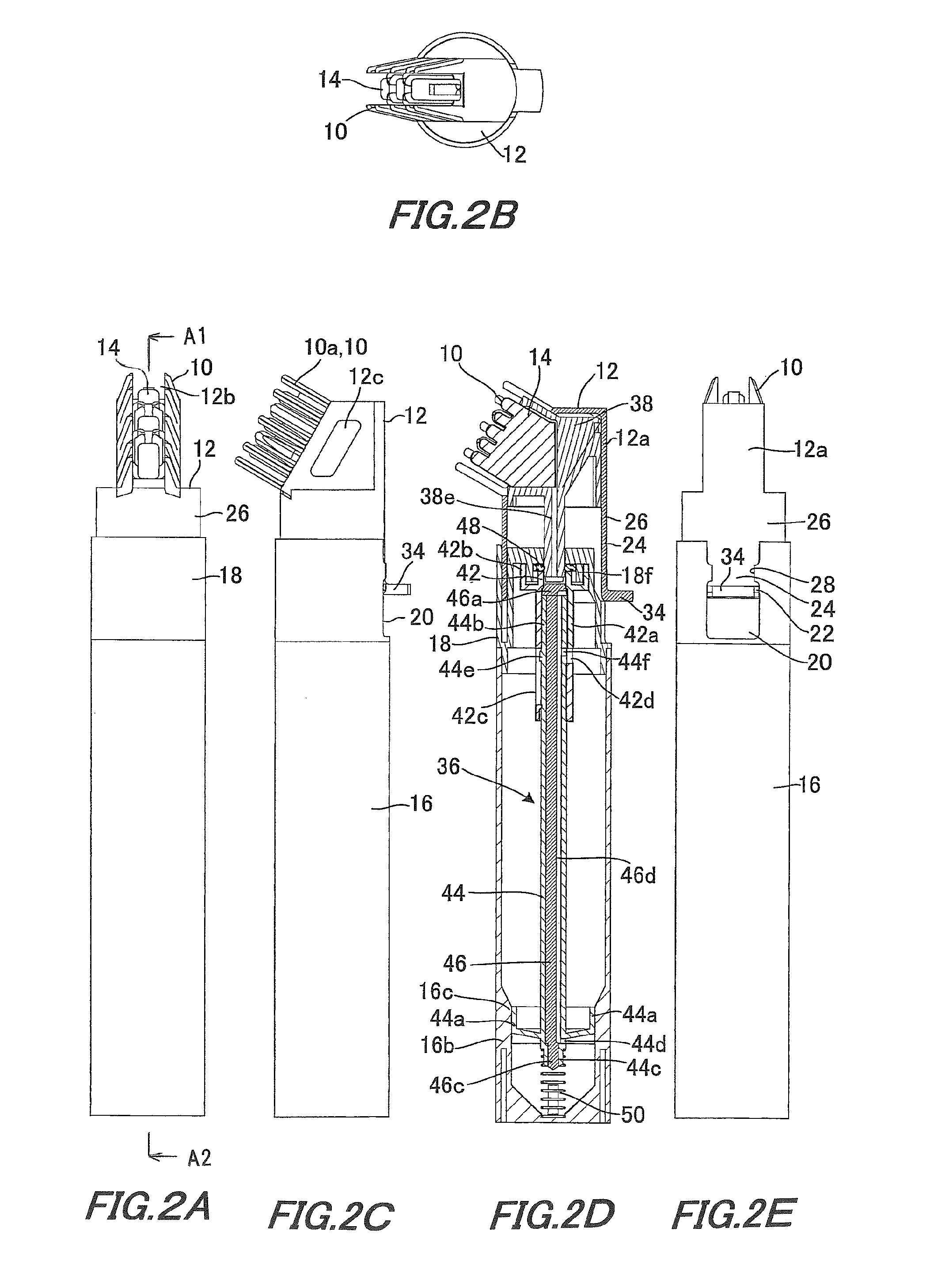Applicator
a technology for applying parts and liquids, applied in the field of haircare applicators, can solve the problems of excessive ejection of application liquids at the next use, inconvenience in handling, and difficulty in knowing the presence or absence of liquids, and achieve the effect of high reflection efficiency of incident light, preventing excessive filling of the applying part, and easy visual confirmation
- Summary
- Abstract
- Description
- Claims
- Application Information
AI Technical Summary
Benefits of technology
Problems solved by technology
Method used
Image
Examples
first embodiment
[0145]The comb-toothed parts 10 arranged around opening 12b that is formed by obliquely cutting off front part 12a are formed of multiple (five in the first embodiment) thin strip-like (bar-like) comb-formed projections 10a extending obliquely with respect to the axial direction and arrayed on the left and right sides.
[0146]Front part 12a of comber 12 has a viewing window 12c formed on the flank for permitting a view of the condition of applying part 14. The aforementioned pressing part 24 is formed in rear part 26 of comber 12.
[0147]Comber 12 may be formed of any material as long as it is resinous and can achieve the function as comber 12. Preferably, use of a resin material excellent in water-repellence and cleansability, such as PP (polypropylene) and the like is desired.
[0148][Applying Part 14]
[0149]As shown in FIGS. 1 to 5, applying part 14 is fitted in the interior of comber 12 with its tips exposed between comb-toothed parts 10 and 10. Applying part 14 is configured such that...
third embodiment
[0231]Next, the applicator will be described with reference to FIG. 27.
[0232]In the applicator according to the third embodiment, as shown in FIG. 27 the comber 12 to which applying part 14 is attached has a different configuration from that of the first embodiment. The comber 12 has a pair of left and right comb-toothed parts 10, each having seven comb-formed projections 10a . . . projectively formed long and short in alternate manner. Applying part 14 is formed so that individual pieces are formed wide and narrow in alternate manner.
[0233]Projections 14a . . . of the applying part 14 and comb-formed projections 10a are correspondingly arranged a fixed distance apart.
[0234]Specifically, in the third embodiment, projections 14a . . . of applying part 14 are formed wide, narrow, wide . . . from top to bottom, as shown in FIG. 27. On the other hand, comb-formed projections 10a which are located corresponding to projections 14a are bent outwards so that the distance of each comb-forme...
fourth embodiment
[0237]In the above, as shown in FIGS. 28 to 41, the comber 12 has an angled U-shaped configuration when viewed from the front side with its front side part open. The large applying part 14 assembled with application liquid feeder 38 is adapted to be inserted rearwards from the front opening part of comber 12 so that large-sized applying part 14 can be fitted easily. The structure of applying part 14 of the fourth embodiment is shown in FIG. 35. However, the above-described structures of FIG. 8 and FIG. 31 and others can also be adopted.
[0238](2) In order to fully spread the application liquid over the aforementioned applying part 14, comber 12 is formed with guttered liquid passage portion 52 that opposes and abuts a gutter structure 38d of application liquid feeder 38. Further, pipe portion 38e under application liquid feeder 38 has a cylindrical configuration to which liquid passage portion 52 of comber 12 is inserted.
[0239]Specifically, shown in FIGS. 32 to 33, inside comber 12, ...
PUM
 Login to View More
Login to View More Abstract
Description
Claims
Application Information
 Login to View More
Login to View More - R&D
- Intellectual Property
- Life Sciences
- Materials
- Tech Scout
- Unparalleled Data Quality
- Higher Quality Content
- 60% Fewer Hallucinations
Browse by: Latest US Patents, China's latest patents, Technical Efficacy Thesaurus, Application Domain, Technology Topic, Popular Technical Reports.
© 2025 PatSnap. All rights reserved.Legal|Privacy policy|Modern Slavery Act Transparency Statement|Sitemap|About US| Contact US: help@patsnap.com



